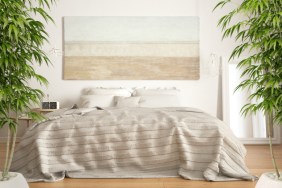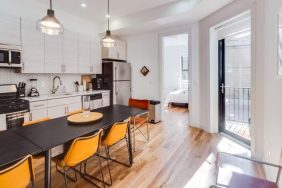Bigger is better. You’ve heard this maxim before, but it’s never been more true than when it comes to interior design trends in windows and doors. Large, glass-paneled doors, measuring up to 60 feet tall and beyond 45 feet wide, are becoming the popular choice for homeowners. This expansive display of glass is particularly common on the West Coast and in mountain areas where blending outdoor and indoor living spaces makes sense. “These go beyond regular patio doors,” says Jon Phelps, public relations and brand content manager at Andersen Windows, a leader in the industry for over 110 years. “You’re literally opening up the side of your house.”

In warmer climates, outdoor rooms have become grandiose, moving beyond a humble place to grill. Many homeowners now expect to have full kitchens, pizza ovens, and pool houses on their properties — and they don’t want to feel as though the outdoors is a separate space. “As people design their outdoor rooms, they want to connect them to the house,” Phelps explains. Some will even match the exterior and interior flooring to keep that sense of continuity.
Also: Perk Up Your Patio With These Designer Tips
For massive doors, glass is the major component, but frames tend to come in wood, aluminum, or a combination of the two. Door frames are trending to be as slim as possible so that when the door is closed, there’s no visual separation between nature, hearth, and home. Slim frames also allow for the maximum amount of sunlight to stream in.

Even with a door that big, the opening is easy. On some models, the outer sides of the paneled door slide inwards. Others fold like an accordion. Some open with as little effort as turning a handle. Motorized, button-controlled doors are also a possibility depending on size.
Another trend in interior design? Curved corner doors, a boon for those who own contemporary homes with art deco influences. Foor these doors, glass is formed into an arc and as the door moves, it glides on the arc for a visually striking statement. Often, homeowners will have a pair of them installed in the corners of the room with a stationary glass panel in between.
As for windows, they are also trending larger. “People are putting combinations together in order to get more glass in their wall,” Phelps says. Frames are getting darker as the industrial look gains popularity on the coasts and in pockets of Chicago and Austin, Texas.

For those who buck the trends, Andersen Windows has the E-Series, a line of windows that can be customized in any shape, color, or grill pattern. “Whatever you’re thinking or dreaming, we can figure out a way to make it happen,” Phelps says. “It’s amazing what people come up with and they’re equally amazed that we can make it happen.”
But what about the rest of the home-owning world that isn’t building homes from scratch? That’s where window replacement comes in. New windows are not only a way to freshen up the aesthetic of your home, they also improve your home’s energy efficiency and, in hurricane-prone areas, can even make your home safer.

When window shopping, remember that you get what your pay for. Value windows will need to be replaced in approximately seven years, while high quality windows will endure upwards of 20 years. Other factors to consider: energy ratings, warranties, and installation. “The installation is almost as important as the unit that you’re putting in,” says Phelps. Windows, he says, are like wheels on a car: it doesn’t matter how high-tech they are if the mechanic doesn’t know how to put them on correctly. In other words: call the experts.






